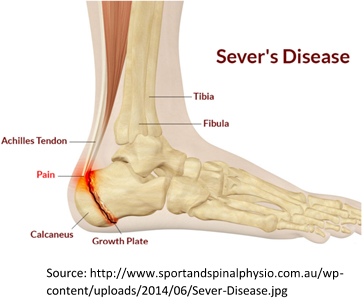Sever’s disease is a very common condition affecting children and causes significant heel pain.
When a child is young, their heel bone (calcaneus) is comprised of two parts. The second part, the part at the back of the heel, starts to appear when they are still young (4-6 years in girls and 7-8 years in boys). The calcaneus remains as two parts until they eventually fuse usually when the child is 12-15 years old. Between the two parts of the heel is a growth plate.
young (4-6 years in girls and 7-8 years in boys). The calcaneus remains as two parts until they eventually fuse usually when the child is 12-15 years old. Between the two parts of the heel is a growth plate.
As the child grows, this growth plate can become irritated, and this is what causes the pain associated with Sever’s disease. Sever’s is usually, although not always, found in children who are involved in higher levels of physical activity or who are going through a growth spurt. This is because the calf muscles attach to this second part of the heel bone by the Achilles tendon. This means that when a child is very active, has tight calf muscles or has a growth spurt where their bones grow too fast for their muscles, the calf muscles pull on this part of the heel bone while it is trying to attach to the main body of the bone and so cause irritation and pain.
The good news is that when the heel bone finally fuses, there is no more growth plate to be irritated and so the Sever’s pain will resolve. Until this time, your podiatrist can help your child manage and reduce their pain.
 Treatment from home:
Treatment from home:
- Place ice in a bag and wrap the bag in a tea towel, use this to ice the area for 5-10 minutes as required to help manage the pain (be careful of slipping afterwards though!).
- Depending on the severity of the pain, it may be a good idea to reduce the amount of activity e.g. one training per week instead of two, only play school sport not both school and club, etc
- Wear shoes all day where possible. Preferably a good pair of joggers as they have a small heel in them which will help with the pain.
Treatment by your podiatrist may include:
- Using orthotics to address foot function or posture issues that may be putting extra strain through the Achilles and so growth plate and worsening the pain.
- Placing a heel lift into your shoes so that your Achilles doesn’t have to stretch so far meaning it won’t pull on the heel as much so reducing pain.
- Recommending certain stretches or exercises to address muscles that could be contributing to the pain.

Comments are closed.